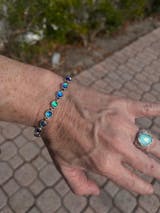Few jewels capture the imagination and express elegance as deeply as sapphires. Sapphires, known for their magnificent blue hues and rich history, have been treasured for generations due to their beauty and symbolic meaning. Among the different types of sapphire jewelry, the real sapphire necklace stands out as a classic piece that many people treasure. In this detailed blog post, we will look at the magical legacy of real sapphire necklaces, including their history, attractiveness, craftsmanship, and significance.
Sapphires have been cherished since antiquity. Their history dates back thousands of years, with early traces discovered in civilizations such as the Greeks, Romans, and Persians. Sapphires were thought to be chips from the earth's pedestal, with their rich blue color reflecting the sky above.
Sapphires were connected with the gods in ancient Greece and Rome, and kings and clergy frequently wore them as a symbol of wisdom and purity. The Greeks, for example, believed sapphires could protect their owners from envy and injury, whereas the Romans connected them with the deity Apollo and believed they might offer protection and favor.
Sapphires became popular in Europe during the Middle Ages as heavenly symbols. Clergy members frequently wore sapphires to represent their connection with the divine. Sapphires were also thought to guard against poison and other ills, which added to their mystique.
Sapphires rose in popularity among European royalty and nobles throughout the Renaissance. The sapphire's rich blue color was regarded as a symbol of nobility, truth, and fidelity, making it a popular choice for engagement rings and other key jewelry pieces.
Sapphires are still highly appreciated today. They have graced royal collections, most notably the British Royal Family. One of the most well-known sapphire necklaces is the one worn by Princess Diana, which now belongs to Kate Middleton, Duchess of Cambridge. This piece has strengthened the sapphire's reputation as a stone of eternal elegance and royal affinity.
The fascination of genuine sapphires stems from their magnificent color and brilliance. While blue is the most well-known color, sapphires can also be pink, yellow, green, or colorless. The most sought-after sapphires are those with a deep, velvety blue tint, sometimes known as "Kashmir sapphires" after the Indian location where some of the best specimens were found.
Genuine sapphires are admired for their clarity and cut. A high-quality sapphire will have exceptional transparency and few imperfections that can alter its appearance. The cut of a sapphire is important because it affects how well the stone reflects light, boosting its natural brilliance and luster.
Sapphires belong to the corundum mineral family, which makes them extremely durable and hard, second only to diamonds. This makes them a good choice for jewelry that will be worn regularly, such as necklaces, which can withstand everyday wear and tear.
The first step in creating a real sapphire necklace is to choose the right stone. Gemologists and jewelers seek out stones with the best combination of color, clarity, and cut. Each sapphire is unique, and finding the ideal one requires both art and science.
Once the ideal sapphire has been chosen, the design procedure begins. Whether the necklace is a single sapphire pendant or a complex arrangement of numerous stones, the design must accentuate the sapphire's inherent beauty. The setting is important in this because it must securely hold the stone while allowing the most light to enter through, boosting the sapphire's brilliance.
A genuine sapphire necklace demands skillful craftsmanship. Each stone is painstakingly cut and set by skilled jewelers, who frequently pair sapphires with diamonds or other expensive jewels to heighten their appeal. The craftsmanship guarantees that each necklace is a work of art, capturing everlasting beauty and sophistication.
Sapphires have traditionally been connected with monarchy and nobility. Their rich blue color has traditionally represented wisdom, virtue, and good fortune. Wearing a genuine sapphire necklace can create feelings of regal grandeur and timeless sophistication, making it a popular option among people looking to convey these attributes. Sapphires are also considered symbols of love and dedication. In many cultures, they are given as gifts on significant anniversaries, particularly the fifth and 45th wedding anniversaries. Their enduring beauty and durability make them an ideal representation of long-term love and commitment.
Sapphires have been thought to have mystical properties in addition to their beauty and symbolic value. Throughout history, they were thought to guard against envy, damage, and poisoning. Some cultures believed sapphires may provide spiritual enlightenment and inner tranquility.
Sapphires are perfect for heirloom jewelry due to their durability and long-lasting beauty. A genuine sapphire necklace can be passed down for centuries, becoming more than just a piece of jewelry. It becomes a cherished family heirloom, loaded with memories and stories that heighten its worth.
A real sapphire necklace is more than just a piece of jewelry; it has a long history, eternal beauty, and profound symbolic significance. The sapphire has captivated and enchanted people since its ancient origins and continues to do so today. A real sapphire necklace, whether worn as a show item or kept as a family treasure, exudes elegance, refinement, and timeless beauty.
Exploring the history, craftsmanship, and significance of genuine sapphire necklaces reveals why these jewels are valued for generations. Their exceptional beauty, adaptability, and profound symbolism make them a classic addition to any jewelry collection. The real sapphire necklace, a symbol of love, commitment, and regal elegance, exemplifies the spectacular gemstone's enduring fascination.


